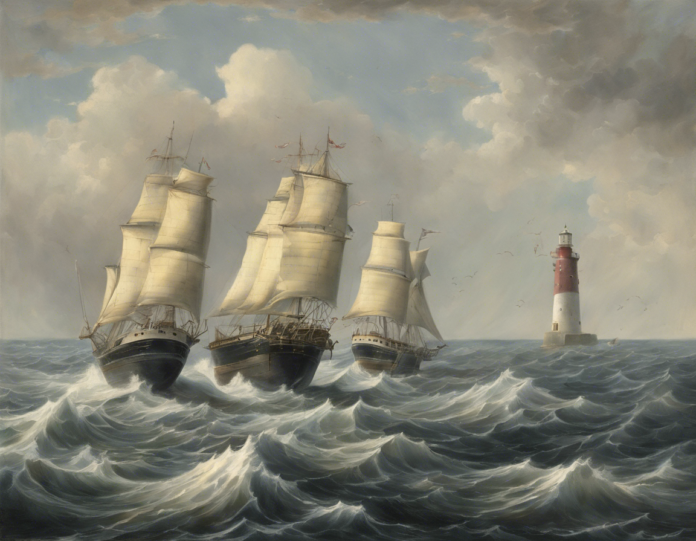Sailing Ships Encounter Lighthouse on the Sea
Sailing ships have navigated the vast seas for centuries, braving the unpredictable waters and relying on various navigational aids to reach their destinations safely. One of the most iconic symbols of maritime navigation is the lighthouse, a beacon of light and safety that has guided countless ships to shore. The encounter between sailing ships and lighthouses has been a pivotal moment in maritime history, marking the transition from traditional navigational methods to modern aids.
History of Lighthouses
Lighthouses have been guiding ships for thousands of years, with the earliest known lighthouse dating back to the ancient Pharos of Alexandria in Egypt, built around 280 BC. These early lighthouses used open flames fueled by oil or wood to signal ships and warn them of dangerous coastlines. Over the centuries, lighthouse technology evolved, with advancements such as the Fresnel lens in the 18th century, which greatly enhanced the range and intensity of the light beam.
Role of Lighthouses in Navigation
Lighthouses play a crucial role in maritime navigation, especially in areas with treacherous coastlines, shallow waters, or hidden reefs. The distinctive light patterns of lighthouses, such as flashing, frequent, or occulting, help sailors identify specific lighthouses and navigate accordingly. In addition to visual signals, lighthouses often emit unique sound signals, such as fog horns, to aid navigation in low visibility conditions.
Encounter between Sailing Ships and Lighthouses
The encounter between sailing ships and lighthouses is a pivotal moment in any sea voyage. As a ship approaches a coastline or harbor, the first glimpse of a lighthouse signals the proximity of land and marks the transition from open sea to coastal waters. The sight of a lighthouse can evoke feelings of relief, as it signifies safety, guidance, and the nearness of civilization after a long journey at sea.
Navigational Challenges and Strategies
While lighthouses are invaluable aids to navigation, they also present unique challenges for sailors. In adverse weather conditions, such as heavy fog or storms, the visibility of lighthouses may be reduced, making it difficult for ships to locate them. To overcome these challenges, sailors rely on a combination of navigational tools, such as radar, GPS, and chart plotting, to supplement the guidance provided by lighthouses.
Famous Lighthouse Encounters
Throughout history, there have been numerous famous encounters between sailing ships and lighthouses that have captured the imagination of seafarers and landlubbers alike. One notable example is the encounter between the RMS Titanic and the Eddystone Lighthouse off the coast of England in 1912. The lighthouse served as a visible landmark for nearby ships but was unable to prevent the tragic sinking of the Titanic.
Modern Lighthouses and Technology
In the modern era, lighthouses have undergone significant technological advancements to enhance their navigational capabilities. Automated lighthouses equipped with solar panels, LED lights, and remote monitoring systems have replaced traditional manned lighthouses, improving efficiency and reducing maintenance costs. Additionally, digital navigation aids, such as electronic charts and AIS (Automatic Identification System), complement the role of lighthouses in guiding ships safely to port.
Conclusion
The encounter between sailing ships and lighthouses symbolizes the timeless relationship between humanity and the sea. Lighthouses stand as beacons of guidance, safety, and hope for sailors navigating the vast oceans, reminding us of the importance of navigational aids in an increasingly complex maritime world. Whether as a picturesque coastal landmark or a lifesaving beacon in stormy seas, lighthouses continue to play a vital role in guiding ships to their destinations and ensuring safe passage for all who venture across the waters.
FAQs (Frequently Asked Questions)
1. What is the purpose of a lighthouse?
- Lighthouses serve as navigational aids to guide ships safely along coastlines and through hazardous waters, alerting them to the presence of land and potential dangers.
2. How do lighthouses produce light?
- Lighthouses historically used open flames fueled by oil or wood. Modern lighthouses utilize advanced lighting technology, such as LED bulbs and Fresnel lenses, to produce powerful beams visible over long distances.
3. Are lighthouses still manned today?
- Many traditional lighthouses have been automated and no longer require full-time staff. However, some historic lighthouses are still maintained by caretakers or volunteers.
4. How do sailors use lighthouses for navigation?
- Sailors use lighthouses as visual landmarks, identifying their unique light patterns and characteristics to determine their position relative to the coastline and other navigational markers.
5. Are lighthouses still relevant in the age of GPS and electronic navigation?
- While modern technology has improved maritime navigation, lighthouses remain essential backup navigational aids, especially in cases of GPS failure or adverse weather conditions.
6. What are some famous lighthouses around the world?
- Some famous lighthouses include the Cape Hatteras Lighthouse in the United States, the Lighthouse of Alexandria in Egypt (one of the Seven Wonders of the Ancient World), and the Peggy's Cove Lighthouse in Canada.
7. How do lighthouses help ships navigate in foggy conditions?
- Lighthouses in foggy regions often emit distinct fog signals, such as sound horns or bells, to alert ships to their presence when visibility is limited.
8. Can lighthouses be visited by the public?
- Many lighthouses welcome visitors and offer tours to the public, providing insights into their history, operation, and importance in maritime navigation.
9. Do lighthouses have unique characteristics for identification?
- Yes, lighthouses have distinctive characteristics such as light patterns (e.g., flashing, fixed, rotating), colors, and tower designs that help sailors differentiate between them and navigate effectively.
10. How are lighthouses maintained and preserved?
- Lighthouses are maintained by government authorities, nonprofits, or local organizations dedicated to their preservation. Regular maintenance, painting, and restoration efforts are essential to keep lighthouses operational and historically significant.
